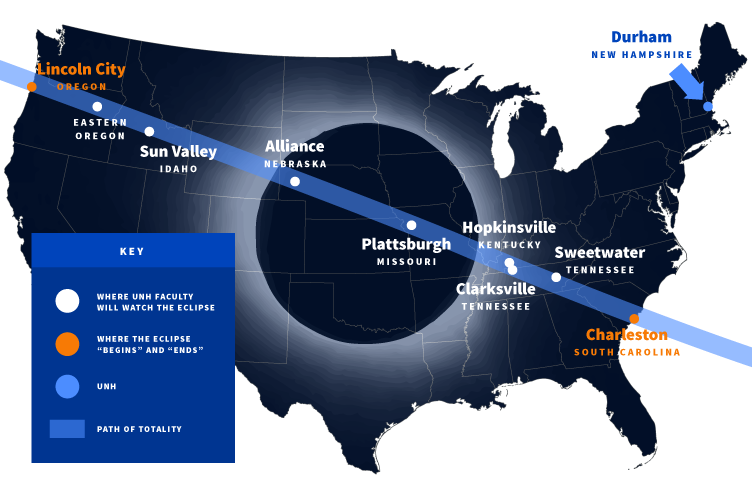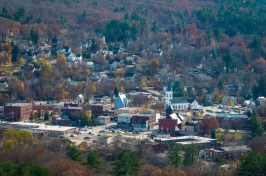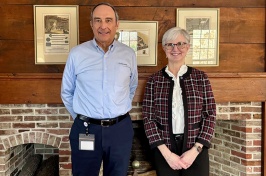
Jody Wilson’s parents live in Ohio. Last August, exactly one year before the first total solar eclipse since 1918 would cross the country coast to coast, they made three hotel reservations in three different states — just in case.
Next week, on Aug. 20, Wilson and his parents will check the following day’s forecast and decide which city will provide the best view of the coming eclipse: Alliance, Nebraska; Hopkinsville, Kentucky; or Clarksville, Tennessee. The three contiguous states are among the 14 in the path of totality, where the moon will completely block out the sun.
“All the people who show up are going to be really excited — like the opening of a sci-fi movie when all the hardcore fans are there.”
Path of totality. It sounds ominous, but to Wilson and other space scientists and researchers, it’s like music — the only place to be when the moon darkens that 70-foot-wide path for, in the best cases, almost three minutes.
“Hopkinsville is about as close as you can get to the path of totality where the eclipse will last the longest (2 minutes, 41 seconds),” says Wilson, a researcher with UNH’s Space Science Center. “There may be tons of people — there are eclipse chasers everywhere, and Hopkinsville will probably have a lot of them. Alliance is in the middle of nowhere so if the weather is going to be better there, it will be worth the drive.”
What he means is, he’ll follow the weather to follow the moon. And wherever that is will be worth the trip.
“You want the sky to be clear but even if it’s cloudy, you will see the effect; it will still be pitch black,” Wilson says. “All the people who show up are going to be really excited — like the opening of a sci-fi movie when all the hardcore fans are there. I’m going to bring 50 pairs of solar viewing glasses, pass them out and say, ‘I’m an astronomer’ and point out things people might want to know.”
The eclipse will first be visible in the U.S. at 10:16 a.m. PDT in Lincoln City, Oregon, a small town southwest of Portland. It will take an hour and 33 minutes for the moon’s umbra shadow to move from the Pacific to the Atlantic and disappear over Charleston, South Carolina.

UNH space plasma physicist Nathan Schwadron says eclipse data “has become a very important complementary data set by which we can understand the structure of the magnetic fields of the sun.”
For UNH physics professor Jim Ryan, also of the Space Science Center, the trip will be part work and part vacation; he plans to fly into Boise, Idaho, with his wife and then drive to Oregon to view the eclipse. He’ll spend the rest of the week in Portland at a meeting of the American Astronomical Society’s (AAS) solar physics division.
“Eastern Oregon is dry desert with more clear days than Portland, so we’ll drive an hour or so north into the path of totality,” Ryan says. “This has been on my bucket list for a while. I have seen many partial eclipses, starting when I was in my teens. But a total eclipse has eluded me, so I am pulling out all the stops to see this one.”
Physics professor Mark McConnell, along with his wife, will be watching the eclipse from the top of Bald Mountain in Sun Valley, Idaho, where he will stay on to attend a meeting of the AAS’s high-energy astrophysics division. Both AAS groups scheduled their meetings to be in the path of the eclipse.
“They’ve even arranged for gondola transportation to the top of the mountain,” says McConnell, adding, “My wife is not nearly as excited as I am. I think she is now slowly becoming aware of what this all means — her excitement is building, but her initial reaction was along the lines of ‘so what’?”
For McConnell, chair of the physics department, the so what is this: He has never witnessed a total solar eclipse and may not get the chance again. “I’ve wanted to see a total solar eclipse for many years. I’ve waited a long time for this,” McConnell, says.
Accompanied by with his wife, grown children and grandchildren, astronomy lecturer John Gianforte will travel to Sweetwater, Tennessee, about 70 miles northeast of Chattanooga.
“If the weather prospects look poor, we'll be driving as far as is practical to see the eclipse,” he says, adding he picked Sweetwater because it will have a long viewing time — approximately 2 minutes and 40 seconds.
“Total solar eclipses are awesome natural spectacles that provide opportunities for us to view the sun in ways not normally available to us,” Gianforte says. “Only Earth lies at the right distance from the sun, with a natural satellite of just the right size that orbits its parent planet at just the right distance to just cover the sun. How could I not attempt to view it?”

Wildcats Watching
Wildcats are everywhere, so we weren’t surprised to hear that some alumni will put themselves along the path of totality on Aug. 21. Brian Capobianchi '03 is one of them. He’ll share stories and photos from Oregon Eclipse 2017 on UNH alumni social media channels. Stay tuned! @UNHalumni @UNHAlums #UNHAlumni
John Gibson can’t remember if it was his idea to take a vacation in the path of totality or his 11-year-old daughter’s. He does recall a conversation last winter when she said she wanted to see the eclipse. So, the family vacation will take them to Plattsburg, Missouri, a path-of-totality city located about 50 miles north of Kansas City.
“I studied the history of astronomy in college and have watched the motions of the sun, moon, planets and stars ever since,” says Gibson, an associate professor of mathematics and statistics. “There's a lot to see and understand just by looking up in the sky and paying attention to the changes of positions of these bodies over the year.”
In addition to his wife, Smita Lahiri, a visiting assistant professor of anthropology, and their two daughters, Gibson’s oldest brother will drive up from Oklahoma City and his youngest sister will come down from Minneapolis to join them for the event.
A partial eclipse will be seen in many states outside the path of totality. In Durham, New Hampshire, it will be visible from about 1:30 p.m. until just before 4 p.m., with the maximum coverage occurring at approximately 2:45 p.m., when the sun will be more than 60 percent covered by the moon.
According to NASA, it is not safe to look directly at the sun during an eclipse without protective solar eyeglasses except during the brief span of a total eclipse. Doing so can result in permanent eye damage.
Find out why UNH graduate C. Alex Young '01G can’t stop talking about the eclipse.
-
Written By:
Jody Record ’95 | Communications and Public Affairs | jody.record@unh.edu

















































